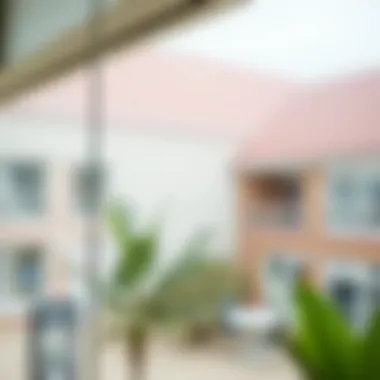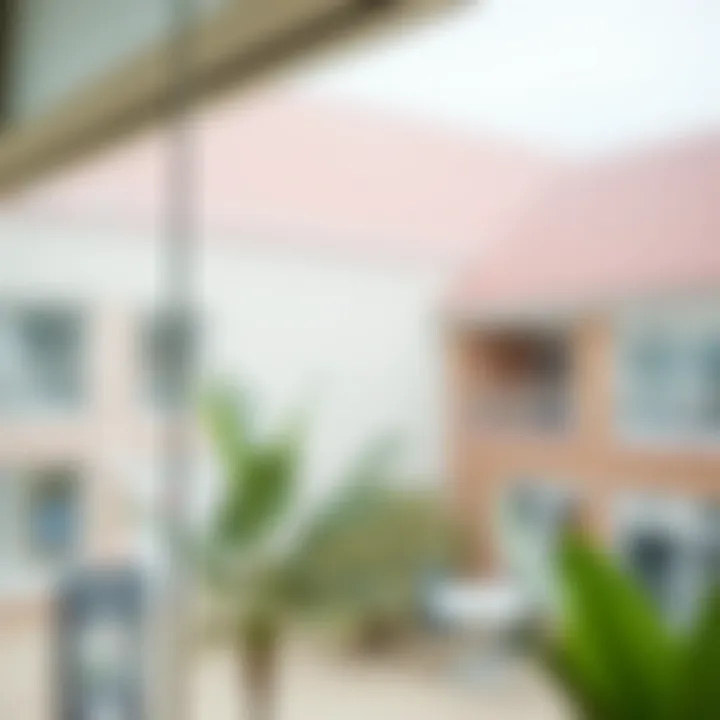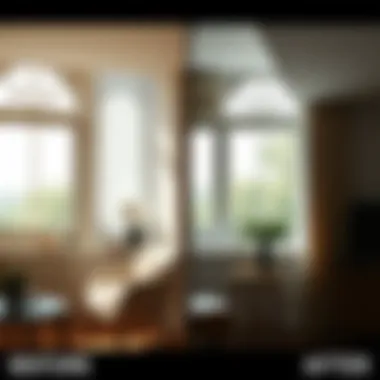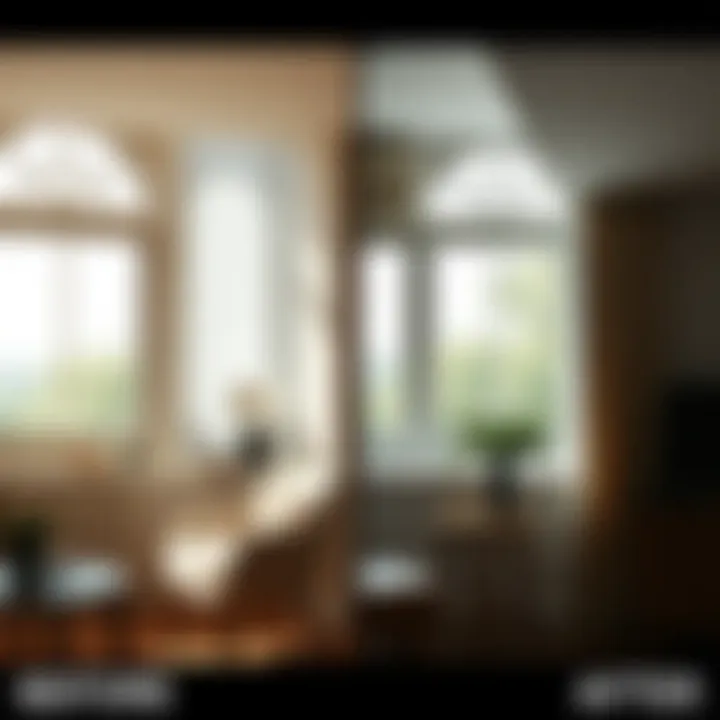Exploring the Benefits of Light Blocking Window Cling


Intro
In recent years, light blocking window clings have emerged as a versatile solution for both residential and commercial properties. As the world becomes more aware of energy consumption and interior comfort, these nifty products have gained traction. They serve not only aesthetic purposes but also practical ones, affecting privacy, energy efficiency, and design. Imagine sitting in a sunlit room without the blinding glare disrupting your focus, or enjoying the peace of mind that comes from enhanced privacy.
The technology that underpins these window films is based on the simple principle of light manipulation. When installed correctly, these clings can significantly reduce heat gain during summers while also shielding interiors from harmful UV radiation. They are particularly appealing as homeowners seek to balance aesthetics with utility in their living spaces. However, the scope of their applications extends beyond mere decoration. This article aims to unearth the myriad ways light blocking window clings can be employed effectively, allowing for smarter choices in home improvement.
In this exploration, we’ll cover how these films function, their implications for energy efficiency, their design variations, and even the technological advancements driving the industry forward. With insights tailored to both consumers and industry professionals alike, this guide seeks to demystify an often-overlooked aspect of modern living, enhancing your understanding of how simple applications can lead to significant benefits.
Understanding Light Blocking Window Cling
Light blocking window clings serve an essential role in contemporary spaces, merging both functionality and aesthetic appeal. With the balance between natural light and privacy becoming more prominent in today’s design considerations, these innovative products have emerged as a viable solution. Understanding their attributes and benefits is crucial for anyone looking to optimize their environments, whether in residential or commercial settings.
Definition and Functionality
Light blocking window cling can be defined as a type of film that adheres to glass surfaces without the need for special adhesives. This cling operates on the principle of static electricity, allowing it to be easily applied and removed. Most notably, these films provide an effective barrier against sunlight, blocking unwanted rays while maintaining a degree of visual comfort. They can take on various forms, from complete opacity to selective translucency, catering to different privacy and light preferences.
The primary functions of these window clings go beyond mere light obstruction. For instance, they can enhance energy efficiency, reducing the reliance on air conditioning in warmer months by minimizing heat gain. Homeowners and business managers alike can benefit from this feature, as it can lead to cost savings on energy bills. Additionally, they often contribute to the overall aesthetic of a space, offering patterns and colors that can enhance interior design.
Mechanism of Light Blocking
The mechanism behind these window clings is quite straightforward yet effective. The clings are typically made from materials such as vinyl or polyester, designed to capture the sun’s rays. When applied to windows, the black or opaque variants work to absorb sunlight while reflecting it, creating a cooler indoor environment. This quality makes them particularly useful in warmer climates or locations with extensive sun exposure.
Moreover, there are variants that utilize reflective coatings that take this light-blocking capability a step further. By reflecting a significant percentage of sunlight, the film helps in maintaining consistent indoor temperatures regardless of the weather outside. This concept is similar to wearing a dark shirt on a hot day; it absorbs heat, yet modern materials aid in retaining that heat effectively indoors when needed.
"Understanding the functionality of light blocking clings can directly influence design choices and energy management strategies in both homes and businesses."
With a comprehension of how these products work and the benefits they provide, individuals can make informed choices about integrating them into their spaces, thus transforming ordinary windows into functional assets.
Types of Light Blocking Window Cling
Understanding the various types of light blocking window cling is crucial for those looking to enhance their spaces with functional yet aesthetic solutions. This section will delve into the different categories available, each tailored to unique needs and preferences. Whether for residential or commercial use, choosing the right type can significantly impact privacy, energy efficiency, and overall appearance of your environment.
Opaque vs. Translucent Options
When considering light blocking window clings, one must decide between opaque and translucent options. Opaque clings are designed to block nearly all incoming light, making them ideal for spaces where privacy is paramount. Think of a home theater or a bedroom where daylight might disturb sleep. Seeing the world outside is unnecessary in those moments. Conversely, translucent clings allow filtered light to enter while still providing a measure of privacy. These are perfect for areas like bathrooms or offices where some natural illumination is desirable without compromising on confidentiality.
- Opaque Options:
- Translucent Options:
- Complete light block.
- Great for bedrooms or home theaters.
- Adds a cozy feel by limiting outdoor distractions.
- Moderates daylight entry.
- Maintains the essence of an open space.
- Suitable for visually communicating a sense of warmth while ensuring privacy.
Ultimately, the choice between opaque and translucent comes down to individual needs and the specific use of each space.
Reflective Clings
Reflective clings serve a dual purpose; they not only provide light control but also act as heat barriers. These window films are often coated with a metallic finish that reflects sunlight, effectively reducing heat gain during warm months. This means lower energy consumption for cooling and less strain on your air conditioning systems.
For instance, a commercial building equipped with reflective window clings might find significant savings in energy costs over time. The offerings are diverse, ensuring that users can select a tint that aligns well with their aesthetic without sacrificing functionality.
"Reflective clings can significantly enhance energy efficiency while adding a modern touch to the building's exterior."
- Benefits of Reflective Clings:
- Reduces heat inside.
- Lowers cooling costs.
- Provides a sleek, modern look.
Colored and Textured Variants
Color can dramatically transform a space, and this is where colored window clings come into play. These variants are not just for aesthetics; they can influence the ambiance and mood of a room. Choice of colors can energize a workspace or create a soothing atmosphere in a personal retreat.
Additionally, textured clings provide an interesting visual element. Options range from frosted designs that mimic etched glass to more intricate patterns that add character to otherwise plain windows. This feature makes it easier to uphold a specific design theme in your home or office space without breaking the bank.
- Colored Variants:
- Textured Options:
- Adjusts the mood of your space.
- Available in a plethora of shades.
- Can create unique atmospheres depending on choice.
- Adds depth and character.
- Mimics expensive treatments at a fraction of the price.
- Perfect for design-centric applications.
In summary, the types of light blocking window cling vary widely, each having unique benefits and applications. From opaque options that dim the light to reflective varieties that keep interiors cool, or even colored and textured clings that enable personalization, the choice ultimately lies in understanding the needs of your space and the impact you aim to achieve.
Applications of Light Blocking Window Cling
Understanding the applications of light blocking window cling is central to grasping its significance in both residential and commercial spaces. These clings serve various purposes that extend beyond mere aesthetics. Their benefits touch on aspects like energy efficiency, privacy, and light control. With the growing awareness of sustainability and energy use, the demand for effective window solutions has surged.
Residential Use
In a residential setting, light blocking window cling has found its niche. Homeowners today prioritize comfort and privacy, and these clings address those needs efficiently. Their ability to reduce glare and regulate indoor temperatures is invaluable, especially during the sweltering summer months. The sleek application of window cling not only marries functionality with style, but it also protects cherished interiors from the fading effects of sunlight.


For example, a living room filled with prized art pieces or delicate fabrics would benefit significantly from window clings that keep harmful rays at bay. Installing such clings is straightforward, allowing homeowners to opt for a self-made installation or hire a professional. This flexibility caters to different budgets and preferences, ensuring everyone can reap the rewards. Thus, residential applications encapsulate the growing trend of optimizing home spaces for comfort and aesthetics.
Commercial Purposes
When it comes to commercial use, light blocking window clings pack a punch. Businesses have recognized the advantage these products offer in creating an environment conducive to productivity while simultaneously enhancing their visual appeal. Office spaces, for instance, are notorious for their sun-soaked, glaring light. By employing window clings, companies can mitigate distractions caused by aggressive sunlight and improve overall employee wellbeing.
Additionally, these clings serve as an effective branding tool. They can be customized to showcase a business logo or tagline, turning plain glass into a canvas of communication. Retail spaces can particularly benefit from this dual functionality—providing privacy to stock areas while promoting brand identity to customers. In this context, light blocking window cling has proven to be a smart investment for a variety of industries.
Specialized Environments
Specialized environments often demand specific solutions to tackle unique challenges. Here, light blocking window clings shine, offering tailored benefits that cater to each setting’s needs.
Medical Facilities
In medical facilities, controlling light is crucial. Light blocking window clings can contribute significantly to patient comfort. In environments such as hospitals and clinics, exposure to bright light can be bothersome, especially for patients recovering from surgery or undergoing treatments. Implementing these clings ensures that patient rooms remain tranquil while preventing unnecessary distractions caused by external noise and visuals. This aspect underscores their popularity within the healthcare sector, enhancing the overall patient experience.
Art Galleries
Art galleries represent another specialized setting where light blocking technology plays an essential role. The preservation of artwork is a primary concern, and these clings provide an effective barrier against harmful UV rays. The ability to manipulate lighting conditions in galleries not only protects art pieces but also influences how visitors perceive and engage with the exhibits. Artists and curators often favor this solution, as it allows for dynamic display settings that can shift depending on the time of day or specific exhibition requirements.
Theater and Performance Spaces
Lastly, theater and performance spaces utilize light blocking window cling to enhance the viewing experience. Controlling ambient light can significantly affect the mood and tone of a performance, so theaters need solutions that allow them to create the perfect atmosphere. Window clings enable these venues to manage daylight levels, affording them a great deal of flexibility when staging productions. When the need arises to set a somber tone or to dim the lights for dramatic effect, light blocking clings can simplify the task. Thus, they have found a variegated foothold within these unique environments, illustrating their broad application spectrum.
"The versatility of light blocking window cling means it can fit into almost any setting, making it a wise choice for those looking to enhance their space's functional and aesthetic appeal."
In summary, from residential areas to specialized environments like medical facilities and art galleries, light blocking window clings serve a multitude of applications. Their effectiveness in controlling light, fostering privacy, and improving energy efficiency makes them a coveted solution for many settings.
Benefits of Using Window Cling
When considering home improvements or modifications to commercial spaces, the benefits of using light blocking window cling cannot be overstated. This feature has made its mark not only due to its functional abilities but also its versatility and appeal. These clings come with a plethora of advantages, catering to various needs and preferences, from enhancing energy efficiency to offering privacy, and even protecting interiors from harmful UV rays. In this section, we delve into these aspects, highlighting why more people are opting for window clings as an effective solution.
Energy Efficiency
One of the most significant benefits of light blocking window clings is their impact on energy efficiency. These products work by reflecting infrared light and blocking harmful ultraviolet rays, thereby reducing heat transfer through windows. This means that during sweltering summer months, the burden on your air conditioning system is lessened, potentially saving you quite a few dollars on energy bills.
Consider the following examples:
- In homes situated in sunny climates, installing window cling can lead to a noticeable drop in indoor temperatures, allowing occupants to remain comfortable without cranking up the AC.
- In offices, the application of clings can stabilize working conditions by maintaining cooler environments, which in turn, boosts productivity levels among staff.
It's clear, window clings aren't just a fad; they're a wise choice for those looking to keep utility costs in check while promoting a more eco-friendly environment. With these clings in place, you won't just save money, you'll also reduce your carbon footprint.
Privacy Enhancement
Achieving a sense of privacy in your home or workspace is often a crucial concern for many. Light blocking window clings provide an ideal balance between natural light and seclusion. Unlike traditional curtains or blinds, clings offer a modern aesthetic and, often, unobstructed views while obstructing the gaze of onlookers.
- High-rises or densely populated areas: Residents can enjoy their space without the constant worry of prying eyes.
- Commercial establishments: Businesses that require patient confidentiality, such as medical clinics, benefit greatly from these clings, allowing them to maintain a professional appearance without compromising on privacy.
Moreover, there are various designs available, enabling users to select a look that complements their decor. It becomes a win-win situation as one can enhance aesthetics while ensuring personal space is respected.
UV Protection
Another vital component of window clings is their ability to protect against UV radiation. Long-term exposure to ultraviolet light can result in detrimental effects such as skin damage, fading of furniture, and deterioration of flooring. Window clings act as a barrier, effectively reducing UV penetration without sacrificing the brightness that comes from natural light.
This protective feature is particularly valuable in:
- Art galleries and museums, where preserving artwork from fading is paramount.
- Homeowners, especially those with children or pets, can feel at ease knowing their interiors are shielded from harmful UV rays, thus prolonging the lifespan of textiles and furniture.
"Choosing light blocking window cling is not just about style; it’s an investment for both health and environment."
In summary, the benefits of using window cling touch on several key areas that are pertinent to modern living—energy savings, privacy, and health. This versatility makes light blocking window clings not just an option but often a necessity in today’s design landscape.
Installation and Maintenance Considerations
The installation and maintenance of light blocking window cling are vital for maximizing their benefits. Understanding how to properly apply and care for these materials can greatly enhance not only their effectiveness but also their longevity. A well-installed window cling can significantly impact energy efficiency, privacy standards, and even the aesthetic appeal of a space.
Proper preparation of the surfaces before installation ensures that the cling adheres well, and learning how to maintain these materials can be a game changer. Here, we will break down the necessary steps for a smooth installation process and how to keep your window cling looking like new for years to come.
Preparing Windows for Installation
The first step in installing light blocking window cling is the preparation of the windows themselves. This is a critical aspect, as any remnants of dust, dirt, or grease can compromise adhesion, which means the cling won’t stick properly. Here are the steps to ensure you have a clean slate:
- Clean the Glass: Use a glass cleaner or a mixture of water and vinegar to remove any grime. Wipe the area with a lint-free cloth, avoiding paper towels that can leave fibers behind.
- Dry Completely: Make sure the surface is dry before the installation. Excess moisture can impede adhesion, creating future bubbles or peeling.
- Inspect for Damage: Look for any chips or cracks in the glass. Damaged areas could lead to tears in the cling or may affect the overall adhesion.
Taking a little time for these steps can resolve common issues that arise during the installation process, ensuring optimal performance of the window clings.
Application Techniques
When it comes to applying the window cling, there are a few techniques one can use, each with its own pros and cons. The two most notable methods are static cling and adhesive applications.


Static Cling vs. Adhesive
Static cling window films are popular due to their ease of application and removal. This type uses no glue, relying on static electricity to bond with the glass. Here are key characteristics:
- Easy Application: Static cling films can be repositioned during installation which allows for a more straightforward application process.
- No Residue Left Behind: When removed, they leave no sticky residue, making them favored for renters or those who frequently change decor.
On the other hand, adhesive window clings offer greater durability and are less likely to lift at the edges.
- Sturdier Hold: Adhesive options are generally more resistant to humidity and temperature changes, which can be crucial in certain climates.
- Varied Choices: They may come in a wider array of designs and thicknesses than static options.
In essence, the choice between static cling and adhesive films will depend on individual needs regarding permanence versus flexibility.
Tools Required
While installing window clings isn't rocket science, having the right tools handy can smooth the entire process. Key tools include:
- Squeegee: A small rubber squeegee is essential for smoothing out air bubbles and ensuring a tight fit against the window.
- Utility Knife: Good for trimming excess cling materials around window edges for a polished finish.
- Measuring Tape: To accurately cut the cling to the desired size before installation, avoid earlier miscalculations.
Having these tools ready can facilitate a hassle-free experience and improve the final look of your window treatment.
Care and Cleaning of Window Cling
Maintaining light blocking window cling involves a few simple steps to uphold their integrity and appeal. Regular dusting can prevent dirt buildup that can mar their appearance, and cleaning them correctly will extend their lifespan. Here are recommended practices:
- Use Mild Soaps: A gentle soap solution can clean them without degrading the material. Avoid using harsh chemical cleaners that might weaken the cling.
- Soft Cloths Only: Use microfiber cloths or similar soft fabrics for wiping down the surface. Scrubbing with abrasive materials can scratch or damage the cling, diminishing its light-blocking ability.
- Inspection for Tears: From time to time, check for any signs of wear or damage. Addressing even minor tears or bubbles early on can prevent greater issues later.
Adhering to these care practices will help retain the effectiveness of your window clings, ensuring they continue to provide their intended benefits without needing frequent replacements.
Technological Advances in Window Cling Materials
In the world of home improvement, staying abreast of technological advancements is key to optimizing both functionality and aesthetics. This is particularly true for light blocking window clings, a product that's come a long way since its inception. Technological advancements in the materials used for window clings not only enhance their performance but also open the door to new applications, making them an increasingly attractive option for consumers and professionals alike.
Smart Window Cling Innovations
Innovations in smart window cling technologies are transforming the way we think about window treatments.
The rise of smart technologies has revolutionized many industries, and window cling materials are no exception. Smart window clings now incorporate advanced features such as sensors and temperature control, allowing users to adjust the level of light that enters a space based on preference or need. For instance, imagine a window cling that automatically darkens when the sun's rays become too intense, thus maintaining a comfortable indoor climate without requiring manual adjustment. This level of sophistication not only improves comfort but also boosts energy efficiency by reducing the reliance on heating and cooling systems.
Moreover, many of these smart clings are designed to integrate seamlessly with home automation systems, enabling remote control via smartphones or voice commands. This kind of convenience appeals to a tech-savvy audience eager to streamline their living spaces while maintaining their aesthetic appeal.
Eco-friendly Options
As the global focus shifts towards sustainability, the demand for eco-friendly materials in all aspects of consumer products has soared. Window clings are no different. New eco-friendly window cling options are being developed using biodegradable materials that minimize environmental impact without compromising on performance. These alternatives not only reduce waste but also cater to consumers' growing consciousness about their ecological footprint.
Additionally, many manufacturers are exploring solvent-free adhesives that further enhance the environmental profile of window clings. Such innovations make it easier for consumers to choose products that align with their values without sacrificing functionality. When selecting window clings, opting for eco-friendly choices can contribute to a healthier planet while providing the necessary benefits such as light blocking and privacy enhancement.
The technological advancements in window cling materials serve as a bridge between functionality, sustainability, and aesthetics. As innovations continue to evolve, consumers and professionals in design and styling can look forward to a broader range of options that support both modern lifestyles and environmental responsibility.
Comparative Analysis with Other Window Treatments
In the realm of home decor and energy efficiency, selecting the right type of window treatment can feel like finding a needle in a haystack. When discussing light blocking solutions, it’s crucial to understand how window clings stack up against other options, including curtains, blinds, and window films. This comparative analysis illuminates not only the pros and cons of each type but also helps consumers make informed decisions tailored to their specific needs.
Curtains and Blinds
Curtains and blinds have long been the go-to solutions for light control in homes and offices. They come in a variety of styles, colors, and materials, often providing an aesthetic appeal that can enhance the overall look of a room. However, they also come with their own set of considerations:
- Flexibility: Curtains can easily be drawn back or closed, allowing for dynamic light control. On the other hand, blinds offer even more precise adjustment, letting in just the right amount of light as desired.
- Insulation: Heavy drapery can provide insulation benefits but may not be as effective as some more modern solutions. This is where light blocking window cling can shine, as it adheres directly to the glass, minimizing heat transfer and maintaining more consistent indoor temperatures.
- Maintenance: Curtains often require regular washing to maintain appearance, while blinds typically need dusting. In contrast, window clings are easier to care for, needing only periodic cleaning with a damp cloth.
- Installtion: Installing curtains or blinds can be a cumbersome task, often requiring additional hardware and measurements. In contrast, window clings are user-friendly, making installation a breeze with no special tools needed.
One must also consider cost, as high-quality curtains and blinds can become quite pricey, while window clings generally offer a budget-friendly alternative that does not sacrifice quality.
Window Films
Window films are another popular choice for homeowners looking to control light and heat. They are typically applied directly to the glass and come in various degrees of opacity and reflectivity. Here’s a closer look at how they compare with light blocking window clings:
- Light Control: While both window films and light blocking clings serve a similar purpose, films can sometimes offer additional benefits like glare reduction and UV protection without altering the view. Yet, many clings now come with enhanced UV-blocking properties and multipurpose functionalities.
- Durability: Window films tend to be more permanent than clings, often requiring professional installation. They can be less forgiving regarding removal, as some films might damage the underlying glass upon removal. Meanwhile, clings can be repositioned or removed entirely with little hassle, making them a more flexible option.
- Customization: While window films may offer specialized designs (like frosted or colored options), light blocking clings can often be produced in unique designs and sizes tailored to individual tastes and window shapes. This allows for greater customization and creativity.
- Environmental Impact: Both solutions can have a positive impact regarding energy efficiency, yet light blocking window clings, especially those made from eco-friendly materials, can offer a more sustainable choice without the energy costs associated with window film production.
Ultimately, choosing between light blocking window clings and other treatments boils down to specific needs and personal preferences. Each option has its benefits, and understanding them will help consumers select the ideal solution suitable for their homes.
"The best window treatment is the one that meets your needs in the most efficient and stylish way possible."
In the end, light blocking window clings not only offer a unique, adaptable solution to those seeking a blend of light control, energy efficiency, and aesthetic appeal, but they also provide a refreshingly innovative option in comparison to more traditional treatments.
Environmental Impact of Window Cling
The discourse surrounding light blocking window cling encompasses not just its benefits and applications, but also its environmental ramifications. As consumers become more eco-conscious, understanding the ecological impact of such products has become paramount. Prioritizing sustainability is vital in the context of window clings, especially since they play a role in energy conservation and resource management. This section delves into key elements concerning the environmental impact of window cling, focusing on sustainability factors and recyclability.
Sustainability Factors
When considering sustainable practices, the first factor to look at is the raw materials used for producing window clings. High-quality window clings are often made with PVC, which can be durable but poses challenges regarding environmental degradation. However, manufacturers have started to develop eco-friendly alternatives from biodegradable or recyclable materials.


The production of such materials typically entails lower carbon footprints than traditional PVC. Furthermore, many brands are now harnessing renewable energy during production, thereby minimizing harmful emissions that contribute to climate change.
Moreover, energy efficiency is a prominent point in the sustainability discussion. By blocking excessive sunlight, window clings can help in reducing reliance on air conditioning systems. This translates to lower electricity usage, diminishing the overall greenhouse gas emissions associated with energy production. Thus, window clings effectively optimize indoor climates while adhering to eco-friendly principles. They serve as a perfect case where design meets function in a responsible manner.
Recyclability and Disposal
After the functional lifespan of window clings ends, their end-of-life management enters the conversation. Recycling practices vary significantly based on the materials used. Standard PVC clings are often not accepted in curbside recycling programs, as they can complicate the recycling stream and impact the recycling process negatively. However, some specialized recycling facilities will accept them, and brands are actively working to improve reclamation processes.
On the other hand, biodegradable clings present a viable option for minimizing landfill contributions. These can break down more readily and thus have lower environmental consequences after disposal compared to traditional materials. It's crucial for consumers to familiarize themselves with local disposal guidelines to ensure they are making responsible choices.
In summary, while light blocking window clings can offer numerous practical benefits, considering their environmental effects adds layers of understanding for consumers and professionals alike. By opting for sustainable materials and responsible recycling practices, window clings can be an environmentally friendly choice that aligns with a growing awareness of ecological impact.
Takeaway: The quest for sustainability in window cling technology reflects a more extensive movement toward greener practices in home improvement and design.
Regulatory and Safety Standards
In an era where building materials and consumer products are increasingly scrutinized, regulatory and safety standards for light blocking window cling are paramount. These standards not only ensure that the products are effective but also guarantee the safety and well-being of users. Following these guidelines can make a substantial difference in both residential and commercial settings. Right from the outset, understanding compliance and health regulations surrounding these materials promotes informed choices.
Compliance with Building Codes
Adherence to building codes is not merely a legal formality; it lays the groundwork for safe and effective product usage within specific environments. Light blocking window clings must meet local and national building codes that address various factors, including fire resistance, material safety, and structural integrity.
- Fire Safety: Certain materials may have flammability ratings that determine if they can be used in particular areas, such as high-rise buildings or homes in wildfire-prone locations. Products that don’t meet these ratings may pose a risk.
- Structural Compatibility: Building codes often set standards on how materials can adhere to existing structures. If light blocking window clings are improperly installed, they could damage the windows or create other safety hazards.
- Regulatory Authorities: Organizations such as the American National Standards Institute (ANSI) and the International Code Council (ICC) publish guidelines that manufacturers must follow. Ensuring that products comply with these standards not only helps in mitigating liability but also provides the consumer a sense of security when purchasing.
Health and Safety Regulations
Health and safety regulations cannot be underestimated when it comes to window treatments like light blocking clings. These regulations cover a range of aspects that directly affect user welfare, from material composition to emission levels.
- Material Safety: Products should be free of harmful chemicals such as VOCs (volatile organic compounds) that can leach into the air, posing health risks over time. Regulatory bodies set limits on these emissions to protect consumers.
- Installation Safety: The application process should be safe, ensuring that users can install the film without risk of injury. Guidance on proper tools and techniques should be easily accessible to prevent mishaps.
- Durability and Lifespan: Regulations often mandate certain performance metrics, including how long a product can resist fading or degradation, which can have implications for indoor air quality.
"When it comes to safety and compliance, knowledge is power for consumers and professionals alike."
In summary, navigating the regulatory and safety landscape for light blocking window clings involves being aware of the intricacies of building codes and health regulations. This knowledge not only empowers consumers to make sound decisions but also fosters a healthier living environment. It is critical for manufacturers to uphold these standards, ensuring that their products are not only functional but safe.
Consumer Considerations
When it comes to choosing light blocking window clings, it is crucial for consumers to weigh their options carefully. Understanding the specific consumer considerations helps in making an informed decision that not only meets practical needs but also aligns with aesthetic preferences.
Cost Analysis
Affordability is often at the forefront of any buyer’s mind. While some may think that opting for budget models makes sense, it might not always reflect the long-term value. Light blocking window clings come in varied price ranges. For instance, premium brands like Gila offer a range of high-quality options that excel in longevity and performance, yet they might carry a heftier price tag. Here are a few factors to consider when analyzing costs:
- Material Quality: Higher quality materials usually cost more but yield better performance.
- Size of Installation: Cost can also fluctuate based on the area to be covered. If you're hanging a substantial section, remember that larger clings or multiple units will be necessary, which adds to the budget.
- Maintenance and Lifespan: Cheaper options may discolor or degrade faster, leading to more frequent replacements, which could ultimately cost more over time.
Ultimately, while the initial investment might feel daunting, it’s wise to evaluate the overall cost-effectiveness rather than just the price label.
Brand Comparisons and Reviews
The market for light blocking window clings is saturated, which leads to challenging but enlightening comparisons among different brands. It’s not just about who offers the best price but involves discerning quality, durability, and specific features. Reviews from other consumers can be instrumental in identifying what works and what doesn't.
Some brands have established themselves through credible feedback and consistent performance, such as:
- Gila: Known for its extensive line and good balance of cost and quality.
- Redi Shade: Offers simpler installation but focuses more on temporary solutions than long-term usage.
- BDF: This brand emphasizes UV protection, perfect for those with sensitive furnishings or artwork.
Before making a decision, here are suggestions to get a clearer picture:
- Seek Ratings on Trusted Platforms: Websites like reddit.com usually offer firsthand user experiences.
- YouTube Demos: Visual comparisons can further illuminate differences between brands.
- Consumer Community Feedback: Engaging in communities, such as those on facebook.com, can yield unique insights into the experiences of other users.
"In picking the right clings, not only is the price important, but one should also consider how the product complements their space, potential return on investment, and overall performance ratings."
Making the right choice in light blocking window clings can significantly affect aesthetics, comfort, and even energy costs in the long run. The balance between the practical aspects of installation and the emotional pull of design is vital in this consumer landscape.
Future Trends in Light Blocking Technology
The exploration of light blocking window cling technology is more than a niche topic in home decor; it's a gateway to understanding the future of our living spaces. With ever-evolving designs and materials, staying abreast of trends helps consumers and professionals alike to make informed decisions. As society becomes increasingly aware of the implications of energy consumption and privacy, light blocking technology rises to the occasion, presenting innovative solutions and applications.
Emerging Technologies
Recent advancements in technology open up new avenues for light blocking window clings. Manufacturers are now blending materials with smart technology, leading to products that not only block sunlight but also adjust to changing light conditions. Imagine window clings that can sense the brightness outside and adapt accordingly! These types of adaptive technologies, often referred to as photochromic films, change their opacity based on light intensity—one minute they're clear, and the next they shield against glaring sun.
Moreover, some brands are beginning to introduce self-cleaning properties within these window clings. With substances designed to repel dust and dirt, homeowners can maintain their aesthetic without needing constant upkeep. It's akin to the way certain surfaces repel stains in furniture; these innovations promise to keep your windows looking sharp without the hassle of frequent cleaning.
Additionally, recyclable materials are gaining traction. The circle of sustainability is closing in on window cling technology, and products made from post-consumer waste are becoming more commonplace. Consumers are beginning to show preference for environmentally friendly options, which not only enhance energy efficiency but also minimize ecological footprints.
"Smart technology in window clings could redefine the relationship between our interiors and the external environment, paving the way for homes truly in tune with nature."
Market Predictions
Looking at the market landscape, the future appears bright for light blocking window clings. As consumer awareness regarding energy efficiency rises, the demand for innovative window treatments continues to grow. Market analysts forecast a steady increase in sales, with projections indicating that the industry may see a compounded annual growth rate of over 15% in the next five years. This trajectory suggests that more manufacturers will enter the space, further enhancing product variety and reducing costs.
Interestingly, shifts in architecture and urban design also play a role in shaping market dynamics. With urban areas expanding and the push for greener buildings on the rise, light blocking solutions will likely be integrated into new designs from the ground up. Emerging red tape like LEED (Leadership in Energy and Environmental Design) compliance is influencing what materials are used, driving interest in sustainable practices that are practical and beneficial.
To stay competitive, companies must not only focus on product innovation but also highlight user experience. This means developing marketing strategies that ensure potential buyers understand the full scope of graphic designs and personalization options available, extending beyond just practical benefits to also address aesthetic preferences.
In summary, as we look ahead, light blocking window cling technology is positioned not just as a tool for managing light; it's an evolving science that illustrates our changing attitudes toward living spaces, energy conservation, and design. Keeping a close eye on these trends offers consumers, designers, and marketers a clearer vision of not only what products to embrace but also the values driving consumer choices in the near future.







